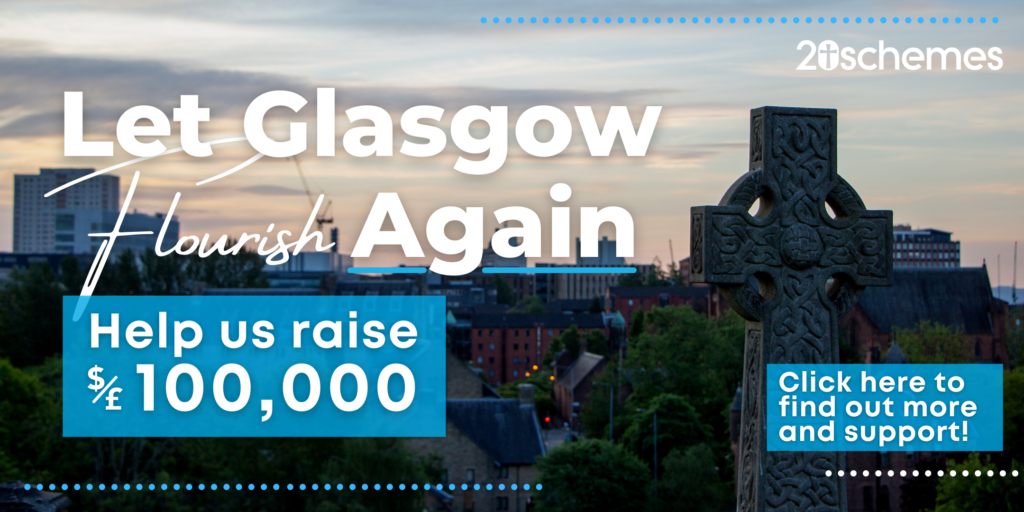One of these Godly men was Andrew Melville. Melville became the Principal of Glasgow University in 1574. He introduced needed reforms and modernised the university, introducing the set-up common today where specialist lecturers teach their specialist subject, rather than one lecturer teaching the full curriculum. Melville was a very significant figure in the Scottish Reformation. He became the leader of the Reformation following the death of John Knox and was the one who secured Presbyterianism as the polity of the Church of Scotland. He also got on the wrong side of King James VI by saying he was but “God’s silly vassal” [1] and made clear to Him that Christ and not the King is Head of the Church.
Following the Reformation, the Covenanters took a stand for Christ’s Headship of the Church, against the King’s attempts to exalt himself to that position. Following the signing of the National Covenant at Greyfriars Kirk in Edinburgh in early 1638, a General Assembly was convened in Glasgow Cathedral in the on the 21st of November 1638 lasting until the 20th of December. The Covenanters dominated the Assembly and swiftly abolished episcopy in the Kirk and throw out the Anglican prayer books that had been imposed on them. A week into the Assembly and the King’s Commissioner the Marquis of Hamilton declared it’s dissolution but they continued to sit in defiance. This is one of the most important moments in the early days of the Covenanter movement. Glasgow was also the scene of the martyrdom of three faithful covenanters, James Nisbet, James Lawson and Alexander Wood. These dear brothers are known as the Townhead Martyrs and their monument can be found at Cathedral Square, part of the outside wall of Glasgow Evangelical Church.
In 1742 in the town of Cambuslang, an area just outside the city of Glasgow, a revival took place through the preaching of none other than the Methodism stalwart George Whitefield. In 1741, inspired by the news of revival in the States under Jonathan Edwards, the local minister Rev. Thomas M’Culloch started preaching the Gospel and calling sinners to repentance. This began to grab the attention of the congregation and the wider community. Whitefield was preaching around Glasgow at the time and received a huge reception when he came to Cambuslang, preaching three-times to huge crowds on the very day of his arrival. One observer described the scene, “People sat unwearied till two in the morning to hear sermons, disregarding the weather. You could scarce walk a yard but you must tread upon some, either rejoicing in God for mercies received, or crying out for more. Thousands and thousands have I seen, before it was possible to catch it by sympathy, melted down under the word and power of God.” [2] Over a century later revival came to another town at the other side of Glasgow, further up the Clyde, the town of Port Glasgow in 1859.
In 1814 the giant of Scottish theology Thomas Chalmers became the minister of the Tron Church on Buchanan Street, now Saint George’s Tron. While in Glasgow, Chalmers would strive to extend the Gospel to the poor and those well beyond the bounds of the church, as well as introducing experimental poor relief work. Chalmers went on to become one of the leaders of the Great Disruption and the first Moderator of the Free Church of Scotland. Many years later, another legend of Scottish theology Sinclair Ferguson would serve in the same church as minister.
The great Scottish missionary, and a personal hero of mine, David Livingstone, while not born in the city, was born in a small village just outside Glasgow called Blantyre. Livingstone became the first European to discover the waterfall on the Zambezi River that he named after the reigning Monarch, the ‘Victoria Falls’. He also discovered several lakes around the same part of Africa. Livingstone was the great hero of Victorian society, he was the icon that boys looked up and aspired to be like, a bit like how 20schemes church planter Pete Stewart is seen today! (Not really).
As a missionary his ministry was not particularly blessed, but the Lord used his expeditions as an explorer to open Africa to the missionaries who came behind him. Livingstone was also a fervent campaigner against the slave trade. By Livingstone’s time in Africa the British Empire had already abolished the practice of slavery, but many other countries continued to exploit Africa in this horrific way. Following his death in 1873 all Livingstone’s years of campaigning against the slave trade led the British Government to act. The Royal Navy was sent out to have a word with the Sultan of Zanzibar. They forced him to sign an edict agreeing to no longer trade in slaves or else they would blow up his Palace. I love that story! Livingstone’s heart is buried in Malawi and his body is interned within the prestigious surroundings of Westminster Abbey. For a poor boy who grow up working in a mill just outside of Glasgow to become the toast of Victorian society and to be buried with Kings is no small blessing. He’s also the only person in this article to have a song written about him by ABBA! A towering statue of this towering figure can be seen next to the Glasgow Royal Infirmary in the Cathedral precinct.
Of all the prominent churches that have proclaimed the gospel in Glasgow, one worth mentioning is the Tent Hall. The Tent Hall had started literally as a Tent in Glasgow Green in 1874 before moving to a building two years later, on Steel Street in the Calton. The church was part of the Temperance Movement of the 19th and 20th Century with a particular outreach to those ensnared by alcoholism. During my time as a student in Aberdeen, one of my elders and his wife had come to Christ through the ministry of the Tent Hall. The building is still there but sadly has now been converted into flats.
Today at Hope Community Church Barlanark, we have several American missionaries serving with us: the Eddins, the Heeke’s and the Davis’, but they are far from the first Americans to come to Glasgow to preach the gospel. Dwight Moody and his musical side-kick Ira Sankey first came to Glasgow in 1874 and stayed for over five months. Moody preached at Glasgow Green and the City Halls to large enthusiastic audiences. They set up shop again twice, in 1882 and 1891. In the 20th Century Billy Graham also came to here, basing his all-Scotland Crusade in the Kelvin Hall in the west-end of Glasgow but also preached in Hampden Park and stadiums throughout Scotland including Tynecastle in Edinburgh and Pittodrie in Aberdeen.
Firstly, on the 21st of March 1955, Billy Graham started his crusade in Glasgow and stayed for six weeks. Billy Graham brought with him a team of American evangelists who were sent out to preach in factories, shipyards and on street corners. The city was abuzz with talk of the crusade and the Gospel became the topic of conversation. On Good Friday the BBC even broadcast his message live from the Kelvin Hall which received the BBC’s second highest viewing figures at the time, only beaten by the Coronation of Her Majesty the Queen. If only the BBC would broadcast gospel messages now! This crusade broke records at the time for Graham also, he later recalled, “We reached a half-million more people in our six weeks in Glasgow and at single rallies in Aberdeen and Inverness than the 2 million we had touched in twelve weeks in London. And the response to the gospel by recorded inquirers, which numbered some 38,000 in London, went beyond 52,000 in Scotland.” [3] 1955 wouldn’t be the last time Graham would come to Glasgow, he returned in the 1960’s to preach at Ibrox Stadium and finally in June 1991 this time preaching at Celtic Park.
This brings us back up to date. Today Glasgow faces many problems: some of the lowest average life expectancy rates in western Europe, the second worst drugs-death crisis in Europe (second only to Dundee) and a continuing alcohol problem which has dogged the city for decades, just to name a few issues. As we depart further and further from Glasgow’s Christian foundations our problems only get worse. Without the Lord’s work Glasgow will never flourish. Rather than turning to politicians and public health experts; judges and prison governors, we need to look to Christ.
Former Free Church of Scotland Moderator, Reverend David Robertson, recently recounted in one of his podcasts his standard practice for dealing with people who would come to his church in Dundee in need of help. He told how he would play them the Coldplay song Fix You and as the song played, he would explain that he couldn’t fix them, “we can’t fix you” Robertson would say, “but we can point you to the one who can, and that is Jesus Christ.” [4] That is so true and not just of the secular authorities who are charged with trying to fix Glasgow’s problems but of us too. We can’t solve all of Glasgow’s problems, but we know where the solution is to be found and it is through sinful Glaswegians like us turning from our iniquities and putting our faith in Jesus Christ.
[1] As Quoted in, Andrew Melville (1545-1622), Institute for the Study of Scottish Philosophy (http://www.scottishphilosophy.org/)
[2] As Quoted in, Cambuslang Revival, UK Wells (http://ukwells.org/)
[3] As Quoted in, Crusade City Spotlight: 1955 All Scotland Crusade, The Billy Graham Library (https://billygrahamlibrary.org/)
[4] Quantum 166 – Blah, Blah, Blah – Nonsense and Sense from all over the world, The Wee Flea, (https://theweeflea.com/)

This blog is part 2 of a series on Glasgow and its great need for gospel churches. You can read Part 1 here and Part 3 here.
It comes as part of our Christmas Challenge, a fundraising appeal to try and raise £/$100,000 to plant three new churches in schemes across the west of Scotland that desperately need to hear the good news of the gospel of Jesus Christ.

 Chris Kerr is a ministry intern serving at Hope Community Church Barlanark. You can support him by going
Chris Kerr is a ministry intern serving at Hope Community Church Barlanark. You can support him by going